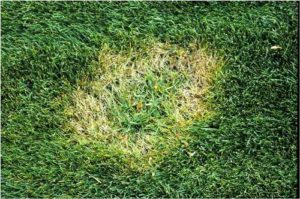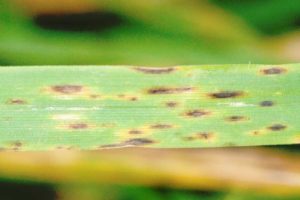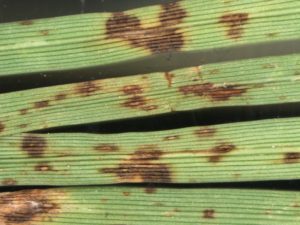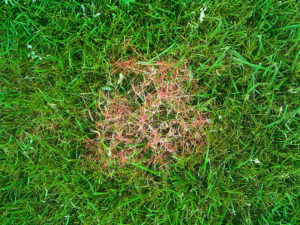How to Identify Lawn Diseases
Top 3 Lawn Diseases
There is nothing more frustrating and pitiful than watching your lawn deteriorate because of a rampant lawn disease. Usually, these lawn diseases are a result of fungal infections that can have debilitating and unsightly effects on the landscape. Therefore, it is important to know about these diseases and some ways to fix them. Here are three of the most common types of lawn diseases that you need to be aware of to keep your lawn in check:
1. Leptosphaeria Korrae![leptosphaeria-korrae]()
It is a lawn disease that is usually known by the name Necrotic Ring Spot and causes brownish-red rings to form across the lawn. If your yard is suffering from this disease, you are likely to see black threads that appear close to the base of each blade of grass. Similar to Melting Out, the best way to fix this lawn disease is to aggressively dethatch and use fungicide applications. Applying a reduced amount of nitrogen fertilizer can help as well.
2. Bipolaris Sorokiniana![]()
This disease is commonly referred to as Leaf Spot and is a characteristic of brown or purple discolorations that appear on the grass blades. As time passes, this untreated leaf spot travels down the blade and may cause the grass to rot, which can thin your lawn and kill the entire plant. There are two methods to cure this lawn disease and prevent your yard from the pesky problem. The first one is to mow at the proper height and the second one is not to allow excess water in the lawn.
3. Drechslera Poae![brown-blight]()
Also known as Melting Out, this lawn disease is typically found in conjunction with Leaf Spot. Similar to Leaf Spot, it causes discoloration along the grass blades that quickly moves to the roots of the grass. It kills off the grass and creates brown patches that keep on increasing in diameter as the disease keeps spreading. To stop this disease in its tracks, you can dethatch and apply fungal spray to the affected areas.
How to Fix Your Lawn Disease Problem
What Is Thatch and How Can You Prevent It?
Use your fingers to separate the blades of grass in your lawn so that you can look through them. You might observe some brownish dead grass between the soil and the green parts of the grass. This brown organic material is known as thatch. It is basically the leaves, vegetation, grass and other organic material that either decompose slowly or do not decompose at all.
While a little bit of thatch can be good for the lawn to retain moisture and act as mulch offering protection from the elements, too much thatch can be harmful as it can house insects, organisms, and bacteria that can destroy your lawn. As the thatch builds up, it can also smother your turf grass. The causes for thatch development include having clay-like soil, fertilizing with too much nitrogen, growing the grass that is extremely thick and hard such as St. Augustine, and waiting for the grass to become too tall before you mow it.
The solution to prevent too much thatch and destruction of your lawn plants is to cut back on nitrogen and mow more often. Moreover, you can thin out the grass, use a substance like gypsum to loosen the soil further, and periodically loosen the soil by power raking and aerating it. To amend the soils that are heavy with clay, the best way is to add compost and avoid fertilizers and any other substance that would make your soil more acidic. Also, avoid the use of pesticides that can kill beneficial worms and organisms as these are actually crucial for converting your clippings into fertilizer and good for aerating the soil.
Check our dethatching guide to learn more
![lawn diseases]() Lawn Fungus and Its Fix
Lawn Fungus and Its Fix
It is not uncommon for lawns to end up with fungus despite proper care. While there are measures that can be taken to avoid lawn fungus, it is mostly dependent on humidity, landscape, and other factors. The fungus usually causes dollar spot fairy rings, brown spot, grease spot, red thread, powdery spot and various kinds of blight. The basic thing you need to rid your lawn of the disease is a fungicide.
Further Ways to Prevent Lawn Diseases
 It is part of gardening to keep your landscape free from all lawn diseases. You need to pay special attention to your watering habits, avoid over fertilization, mow often, aerate your lawn once or two times in a year, and be cautious with pesticides. Furthermore, you can eliminate lower areas in your lawn as they allow the disease to flourish and water to accumulate, grow proper turfgrass for your environment and region, and improve drainage in the lawn by removing the high spots. Air circulation can be improved, and sunlight can be increased by trimming the shrubs and trees. Perform soil tests regularly i.e. after every three to five years and make sure you follow the test recommendations and the appropriate fertilizing regime for the turf grows. Make sure you always use the proper soil when adding to your yard to fix identified problems.
It is part of gardening to keep your landscape free from all lawn diseases. You need to pay special attention to your watering habits, avoid over fertilization, mow often, aerate your lawn once or two times in a year, and be cautious with pesticides. Furthermore, you can eliminate lower areas in your lawn as they allow the disease to flourish and water to accumulate, grow proper turfgrass for your environment and region, and improve drainage in the lawn by removing the high spots. Air circulation can be improved, and sunlight can be increased by trimming the shrubs and trees. Perform soil tests regularly i.e. after every three to five years and make sure you follow the test recommendations and the appropriate fertilizing regime for the turf grows. Make sure you always use the proper soil when adding to your yard to fix identified problems.
Mowing techniques include mowing when the height is correct for the grass, changing the mowing pattern every time you mow so that there is no grain established, mowing using a sharp blade so that there are no ragged cuts, and mowing when the grass is dry. Since fallen leaves can be home to diseases and pets, it is better to keep your lawn free of debris and leaves. You should water in the early morning so that evaporation could take place during the day, and water frequently and deeply to promote deeper root systems.
Even when you follow these instructions, you are still likely to have the occasional issue, but the chances are that you can resolve the issues unless it involves some extreme danger. Early detection is one of the best ways to head off problems, so keep your eyes open and identify and deal with weeds, pests, and lawn diseases before they are established.








Comments are closed, but trackbacks and pingbacks are open.